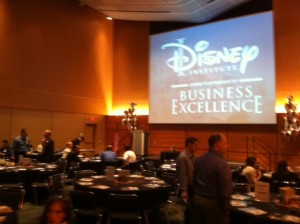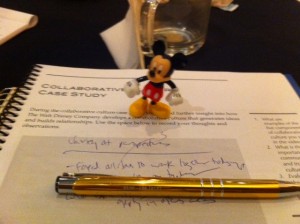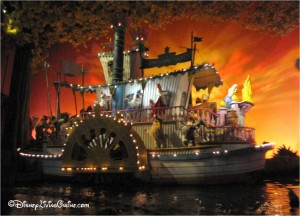Review: The Disney Institute
By Dave Shute
WHAT IS THE DISNEY INSTITUTE?

Through a variety of paid programs, it aims to help people build their toolkit to enable cultural change in organizations –particularly, but not only, in improving the quality of service delivery.
Disney Institute programs are delivered in single and multi-day sessions at Walt Disney World and Disneyland. Single day sessions are also done in various cities.
In addition, Disney will deliver a customized program at an organization’s site, and engage with organizations in long-term change journey.
See this for the current set of topics and current calendar of programs available to the general public.
I had the chance to see one of Disney Institute’s one-day programs a few weeks ago in my home town.
I thought it was terrific. But I know I am odd. So here’s a couple of thoughts for those less odd:
- Don’t attend a Disney Institute session unless you’ve to Disney World or Disneyland at least once–so those here planning their first time visit, don’t attend a session yet!
- Start by reading the key books first–they are much cheaper than attending a session
- If the books resonate with you, then try a one-day session, nearby or at Disney World
- Getting the full value out of the Disney Institute concepts requires sustained top leadership commitment and likely extensive changes in their behaviors.
- If you aren’t the top leader, or the head of a unit with major control (e.g. over hiring, orientation, training, operations, etc.) then you need to get your top leaders on board. Major change takes a multi-year effort that starts at the top.
- It’s not about making front-line staff less annoying–your front-line people are annoying because by neglect or by mistake you’ve made it rewarding for them to be so. So it’s about the leadership team putting together a system of values, behaviors and processes that encourage, enable, and reward great service.
REVIEW: THE DISNEY INSTITUTE
I saw a full-day program on “Disney’s Approach to Business Excellence” at a local meeting room. This is a kind of summary program that covers the key components–“leadership excellence, people management, quality service, brand loyalty, and inspiring creativity”–of Disney’s approach.
Some of you–perhaps thinking of this or of this, or recalling brushes with corporate failure in the 20s, 30s, 40s, etc.–might be surprised that Disney has the credibility to teach excellence.
In the management world, however, Disney has a tremendous reputation for effectiveness (which perhaps says more about management than it does about Disney).
In particular, Disney is highly regarded for what is sometimes called “service excellence” but what Disney calls “quality service.”
For “quality service” read Cast Members: the regular, not all that well-paid, Disney employees who, day in and day out, produce magic and smiles, not only when things are going well, but also when they are going poorly.
The various Disney Institute programs are overviews or deep dives into topics on running the kind of organization that finds, develops, enables and supports these kinds of people. The programs are delivered by former or current cast members and leaders.

Because of that expense, I’d start with a couple of books first:
- The “official” book, by Theodoric Kinni and The Disney Institute, is Be Our Guest: Perfecting the Art of Customer Service
, a newly revised version of a book about Disney approaches that first came out a few years ago
- An almost-official addition (it is promoted on the Disney Institute website) is Lee Cockerell’s Creating Magic: 10 Common Sense Leadership Strategies from a Life at Disney
. Cockerell, I suspect, was part of the soul of the Disney Institute when he lead operations in the parks and resorts at Disney World, and his book not only reinforces the main messages of the Institute, but also puts them into the context of his own personal story, both before and during his Disney World years.
Disney World fans who are also interested in leadership issues should read Cockerell’s book first, and then Kinni’s. Those whose interests start and end with leadership should reverse the order.
Both books have a couple of key things in common:
- They illustrate that the principles they articulate can work, by giving examples of how other organizations have used them
- They don’t understate how much time and effort the senior team needs to put into this kind of change
Too many business books (and management development enterprises) have the direct or implicit message of “do these 6 things for 30 days and you’ll see great results.” The Disney Institute does not take this approach, but rather is realistic about what it takes to bring about major change.
An example of the link from strategy to cultural values to operations: an early distinction Walt Disney tried to set between Disneyland and competing amusement parks was keeping it very clean. This value was trained, but it came to life because senior leaders acted like it was important, and would go out of their way to clean trash themselves.
People often don’t pay much attention to training or to what leaders say; they pay a lot of attention to what leaders do.
As an operational support to the strategic thrust, Disney measured the optimal distance between trash cans to make it almost as easy for guests to put trash in cans as it was to toss the trash aside.
My one-day session was an overview of the key Disney themes. As a result, the presenters had a lot of information to get through, and they did so with grace, clarity, informality, and lots of stories about Disney World.
They used a multi-media presentation on two huge screens which they tag-teamed through, direct engagement with the audience, group sessions at the tables, and individual work in a workbook.
However, the need to cover all the basics meant they had less time to tell stories about how the principles they were working through had helped other companies than Disney, and other people like those in the room. This was too bad, as such stories help build conviction in the usefulness of the material.
The room held about 240 people at 10-person round tables. Some of the tables had been bought by companies, and some were filled with individuals who had signed up.
My table included one person who had never been to Disney World, but the rest were veterans–at least three had been to Disney World more than 20 times.
WHAT CAN THE DISNEY INSTITUTE DO FOR YOU?
Disney World is not remotely perfect.
Any organization of more than one person and with more than one goal cannot be perfect, because people are messy and goals sometimes conflict.
Even sharp priorities among goals get complicated in the details.
For example, Disney has a hierarchy of standards: safety first, then courtesy, then show, then efficiency last. Ordering these standards is of great help to routine decision making, as it allows quick resolution when they come into conflict. An egregious safety issue that can only be responded to by a minor gap in courtesy is responded to regardless of the effect on courtesy.
Many organizations have such lists–they may call them “values,” not standards as Disney does–but without them arranged in order, when values conflict, an un-ordered a list of values can cause paralysis or inconsistency instead of guidance.
Even with ordered values, problems comes with conflicts among lower-level priorities with disproportionate impact.
At Disney World, you’ll see this issue most commonly on the trade-off between “Show” and “Efficiency.” A minor degradation in show that yields a major improvement in efficiency may be allowed to pass, and where the right line to draw between these is to be found can be a huge point of conflict between Disney World management and Disney fans.

Fixing this would require not just spending money but also a multi-month shut-down to one of the Magic Kingdom’s best-loved rides.
This shutdown has been resisted, I suspect, partly because of its effect on lines in the rest of the park. But with the Fantasyland expansion adding capacity this year, I think we’ll see that the trade off terms have changed, and Splash will get the renewal that it needs and deserves.
Organization can’t be perfect, but they can be better or worse.
Making organizations better is not something that happens by chance; it’s a thoughtful, purposeful, comprehensive journey, and one that constantly iterates from the highest issues of values to the tiniest details of operations, and then back again.
The complexities of decisions made by imperfect people in the context of conflicting goals means that Disney World–like any other organization–will constantly make mistakes, some of them large, some comic, some both.
Yet even so, the cast members at Walt Disney World are probably the single most remarkable group of employees ever created anywhere.
Most of the credit for this belongs to the cast members themselves, and who they are to start with.
But the rest of the credit belongs to Disney for the culture, systems and processes it has devoted to selecting, training, developing, enabling, and rewarding them.
You can learn a lot about how this works, and how it might apply to you as a leader, from these books and from the Disney Institute programs.
The Institute’s website–whose design I’m not that keen on–is here. The current program calendar is here. And the key books are Be Our Guest and Creating Magic
.



3 comments
I work in Development and Fundraising, how would I benefit from the Disney Institute
Jackie, the DI stuff is pretty generic–how to be more creative, how to lead people.
Fantastic review. I’ve been looking for info like this to see if the principles of the program would benefit a school environment, as I teach high school. Obviously school is not a business, but I think there are more parallels than people realize, most notably the fact that we have MANY types of people come through our doors and we have to cater to each one to some degree or else we end up with a large number of failures. We also have a large number of employees with different goals. I’ll have to look into picking up the books that you referenced.
Thanks for covering this program in such depth.
Leave a Comment | Ask a Question | Note a Problem